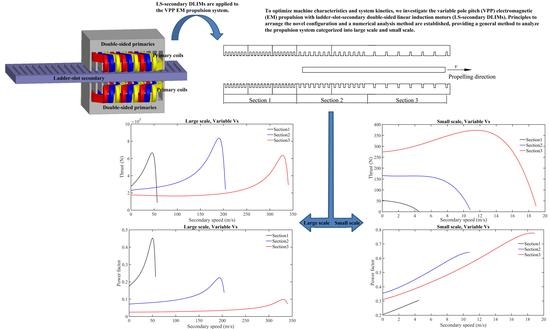Variable Pole Pitch Electromagnetic Propulsion with Ladder-Slot-Secondary Double-Sided Linear Induction Motors
Abstract
:1. Introduction
2. Design and Numerical Analysis of the Ladder-Slot-Secondary Double-Sided Linear Induction Motors (LS-Secondary DLIM)
2.1. Equivalent Circuit Considering the End Effect
2.2. Numerical Analysis of Characteristics
3. Variable Pole Pitch (VPP) Electromagnetic (EM) Propulsion
3.1. Arrangement of VPP DLIMs
- The secondary dimensions, including the cogging ratio, ladder width, and slot width, should be remain constant during the whole operating process.
- The slot combination between the primary and secondary must be the same among sections.
- The primary width is maintained all along the propelling direction.
- The maximum synchronous speed of the LS-secondary DLIMs is the same as the terminal speed of the EM propulsion.
- Sections with a constant Vs, have the same synchronous speed.
- Sections with variable Vs, have different synchronous speeds.
3.2. Numerical Analysis of VPP EM Propulsion
4. Simulation and Experiment
5. Conclusions
Acknowledgments
Author Contributions
Conflicts of Interest
Appendix A
| Symbol | Parameter | Symbol | Parameter |
|---|---|---|---|
| Estr | Elastic modulus | b2 | Ladder width |
| Fe | Thrust | cosφ | Power factor |
| I2e | Eddy current in the LS-secondary | d2 | Secondary thickness |
| Im | Modified magnetizing current | f | Supply frequency |
| Im0 | Magnetizing current without longitudinal end effect | k | Cogging ratio |
| Kc2 | Carter’s coefficient | ka | a/τ |
| Kdp1 | Primary winding factor | kb | Permitted deflection |
| L1 | Primary leakage inductance | kmax | Maximum deflection |
| L2 | Secondary length | lδ1 | Primary stack width |
| L21 | Secondary leakage inductance referred to primary | lδ2 | Secondary width |
| Lm | Modified magnetizing inductance | m | Mover mass, including secondary mass and loading mass |
| Lm0 | Magnetizing inductance without end effect compensation | m1 | Number of supply phases |
| N | Number of ladders | n | Total number of sections in the VPP EM propulsion |
| Ql1 | The lth ladder’s left edge on normalized time scale | p | Pole-pair number |
| Ql2 | The lth ladder’s right edge on normalized time scale | q | Primary slots per pole per phase |
| R21 | Secondary resistance referred to primary | s | Slip of secondary velocity |
| Rm | Modified magnetizing resistance | s0i | Initial slip in the ith section |
| S | Displacement | v | Secondary speed |
| T | Performance period | w1 | Number of turns per phase |
| Te | EM shear stress | τ | Pole pitch in meters |
| Te,max | Maximum of EM shear stress | τb | Shear strength |
| Vs | Synchronous speed | τmax | Maximum structural shear stress |
| VT | Terminal speed of the EM propulsion | σb | Tensile strength |
| ZLS | Equivalent circuit impedance | σmax | Maximum structural normal stress |
| a | Primary width | ω | Synchronous angular speed |
| b1 | Sum of ladder width and slot width |
| Parameter | Unit | Data | Parameter | Unit | Data |
|---|---|---|---|---|---|
| Phase number | - | 3 | Air gap (one side) | mm | 5 |
| Supply voltage | V | 220 | Secondary thickness | mm | 20 |
| Synchronous speed | m/s | 4.5 | Secondary length | mm | 185 |
| Supply frequency | Hz | 50 | Number of ladders | - | 11 |
| Pole-pair number | - | 2 | Ladder width | mm | 11.5 |
| Slots per pole per phase | - | 1 | Slot width | mm | 5.75 |
| Pole pitch | mm | 45 | Tensile strength | MPa | 124 |
| Primary thickness | mm | 65 | Shear strength | MPa | 165 |
| Yoke height | mm | 30.7 | Permitted deflection | mm | 0.575 |
| Tooth height | mm | 39.8 |
References
- Stumberger, G.; Zarko, D.; Aydemir, M.T.; Lipo, T.A. Design and comparison of linear synchronous motor and linear induction motor for electromagnetic aircraft launch system. In Proceedings of the 2003 IEEE International Conference on Electric Machines and Drives (IEMDC’03), Madison, WI, USA, 1–4 June 2003; Volume 1, pp. 494–500. [Google Scholar]
- Hellinger, R.; Mnich, P. Linear Motor-Powered Transportation: History, Present Status, and Future Outlook. Proc. IEEE 2009, 97, 1892–1900. [Google Scholar] [CrossRef]
- Ravanji, M.H.; Nasiri-Gheidari, Z. Design Optimization of a ladder secondary single-sided linear induction motor for improved performance. IEEE Trans. Energy Convers. 2015, 30, 1595–1603. [Google Scholar] [CrossRef]
- Koseki, T.; Sone, S.; Yokoi, T. Investigation of secondary slot pitches of a cage-type linear induction motor. IEEE Trans. Magn. 1993, 29, 2944–2946. [Google Scholar] [CrossRef]
- Mu, S.J.; Chai, J.Y.; Sun, X.D.; Wang, S.M. A variable pole pitch linear induction motor for electromagnetic aircraft launch system. IEEE Trans. Plasma Sci. 2015, 43, 1346–1350. [Google Scholar]
- Mu, S.J.; Chai, J.Y.; Sun, X.D.; Wang, S.M. A novel linear induction motor for electromagnetic aircraft launch system. In Proceedings of the IEEE 2014 17th International Symposium on Electromagnetic Launch Technology (EML), La Jolla, CA, USA, 7–11 July 2014; pp. 1–5. [Google Scholar]
- Zhang, Z.H.; Shi, L.M.; Li, Y.H. Characteristics of double sided linear induction motors with ladder-slit type secondary. Trans. China Electrotech. Soc. 2014, 29, 103–110. [Google Scholar]
- Lee, B.J.; Koo, D.H.; Cho, Y.H. Investigation of linear induction motor according to secondary conductor structure. IEEE Trans. Magn. 2009, 45, 2839–2842. [Google Scholar]
- Yoon, S.B.; Jung, I.S.; Kim, K.C. Analysis and optimal design of the slit type low speed linear induction motor. In Proceedings of the Electric Machines and Drives Conference Record, Milwaukee, WI, USA, 18–21 May 1997; pp. TB2/8.1–TB2/8.3. [Google Scholar]
- Park, S.C. Thrust and attraction force calculation of a linear induction motor with the moving cage-type secondary. In Proceedings of the 2003 Sixth International Conference on Electrical Machines and Systems (ICEMS 2003), Beijing, China, 9–11 November 2003; Volume 1, pp. 226–229. [Google Scholar]
- Park, S.C.; Kim, B.T. Effect of contact resistance between side-bar and secondary conductors in a linear induction motor with a cage-type secondary. IEEE Trans. Magn. 2003, 39, 1562–1565. [Google Scholar] [CrossRef]
- Naugher, L.A.; Baker, N.J.; Atkinson, G. Large air gap squirrel cage induction generator for a tidal turbine. In Proceedings of the 8th IET International Conference on Power Electronics, Machines and Drives (PEMD 2016), Glasgow, UK, 19–21 April 2016; pp. 1–6. [Google Scholar]
- Dalal, A.; Singh, A.K.; Kumar, P. Effect of saturation on equivalent circuit analysis of induction motor in practical scenario. In Proceedings of the 2013 Annual IEEE India Conference (INDICON), Mumbai, India, 13–15 December 2013; pp. 1–5. [Google Scholar]
- Amiri, E. Study of linear induction motor end effects using 3-D FEM and equivalent circuit. In Proceedings of the 39th Annual Conference of the IEEE Industrial Electronics Society (IECON 2013), Vienna, Austria, 10–14 November 2013; pp. 3165–3170. [Google Scholar]
- Duncan, J. Linear induction motor-equivalent-circuit model. IEE Proc. B Electr. Power Appl. 1983, 130, 51–57. [Google Scholar] [CrossRef]
- Fan, Y.; Di, J.; Liu, Y.J. Numerical Analysis of the Double-Sided Linear Induction Motor with a Ladder-Slot Secondary. 2017, in press. [Google Scholar]
- Patterson, D.; Monti, A.; Brice, C.W.; Dougal, R.A.; Pettus, R.O.; Dhulipala, S.; Kovuri, D.C.; Bertoncelli, T. Design and simulation of a permanent-magnet electromagnetic aircraft launcher. IEEE Trans. Ind. Appl. 2005, 41, 566–575. [Google Scholar] [CrossRef]
- Hibbeler, R.C. Analysis of Statically Determinate Structures. In Structural Analysis, 8th ed.; Prentice Hall: Upper Saddle River, NJ, USA, 2012; pp. 33–61. [Google Scholar]
- Shanghai University of Technology, Shanghai Electric. Design of linear induction motors with non-magnetic secondary. In Linear Induction Motor, 1st ed.; China Machine Press: Beijing, China, 1979; pp. 59–79. (In Chinese) [Google Scholar]
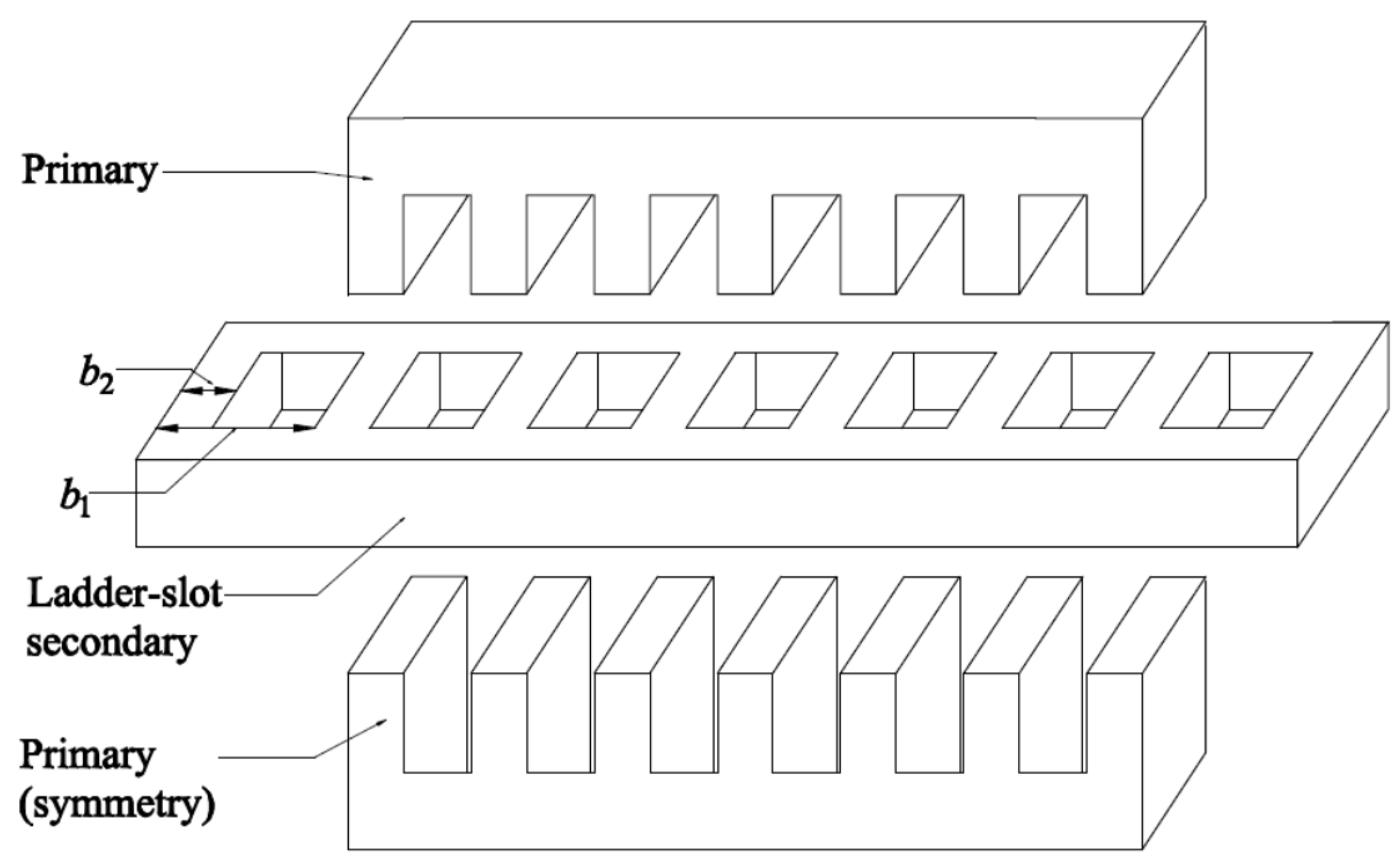




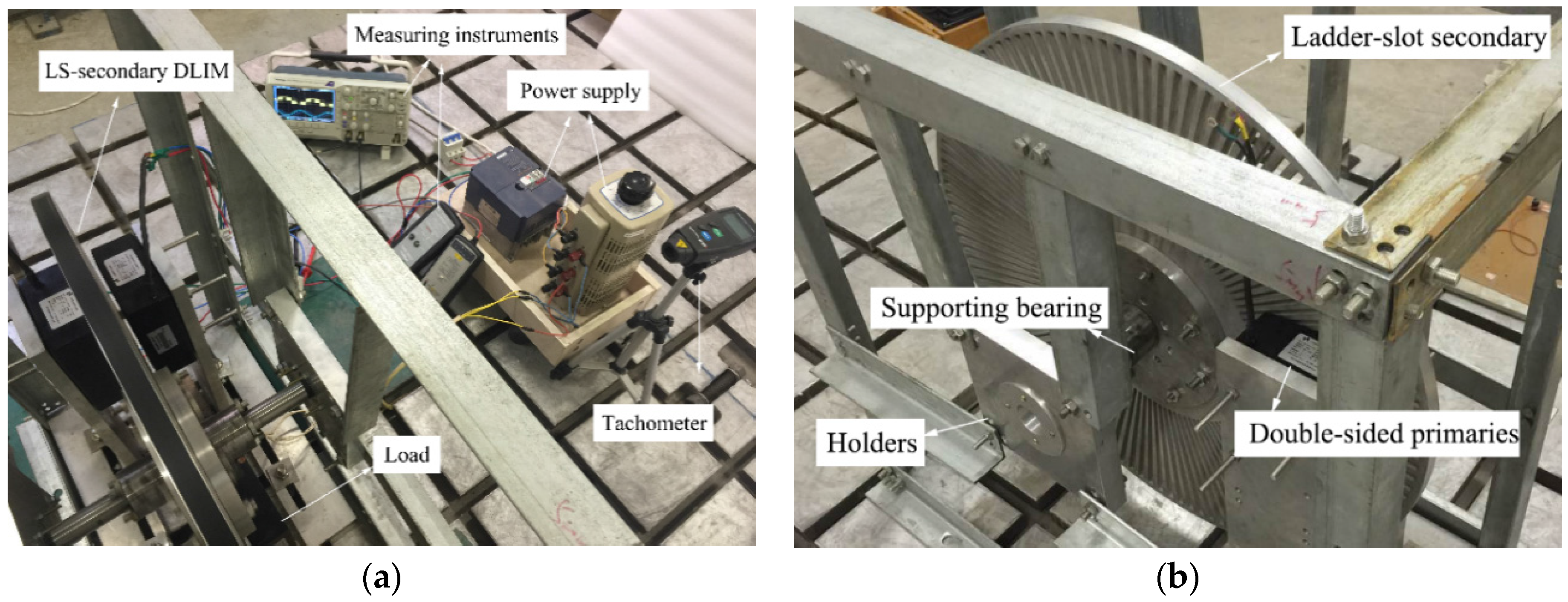

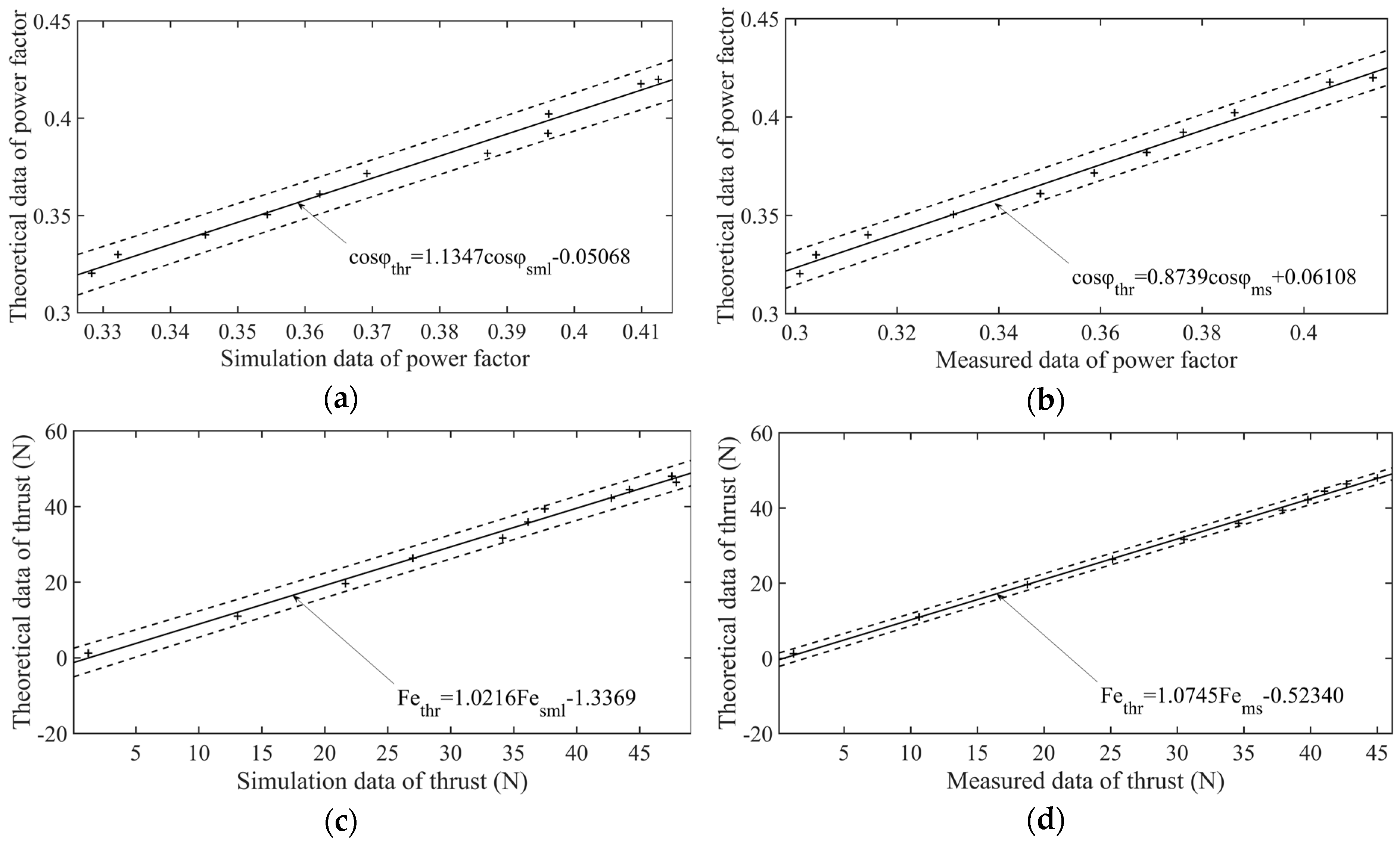
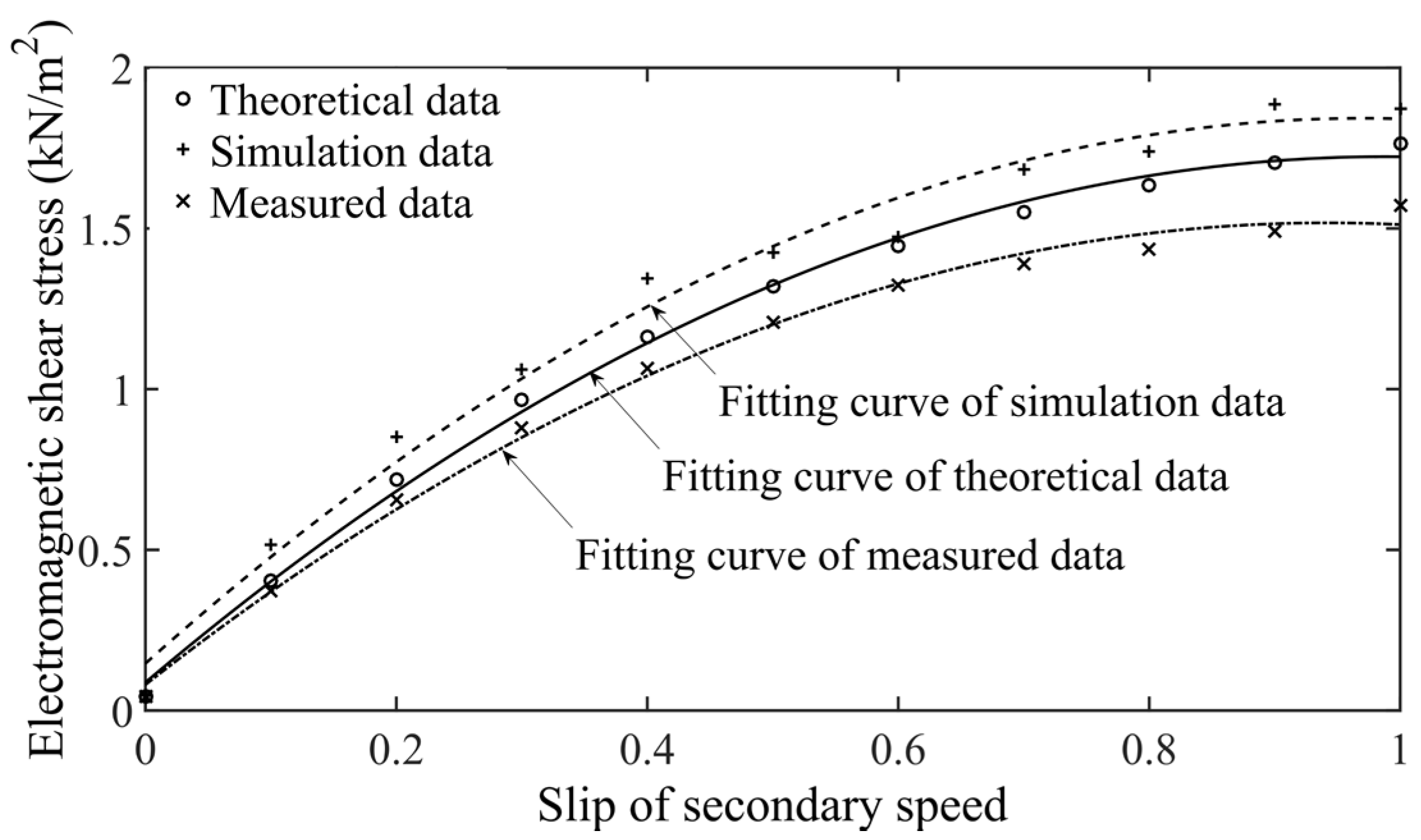
| Supply Voltage | Category | Section | q | Vs (m/s) | f (Hz) | ka | Displacement (m) | Performance Period (s) | Te,max (kN/m2) |
|---|---|---|---|---|---|---|---|---|---|
| 10 kV | Sections with a constant Vs | 1 | 1 | 340 | 300 | 1.44 | 172.81 | 6.18 | 33.2 |
| 2 | 2 | 340 | 150 | 0.72 | 2254.41 | 17.59 | 17.4 | ||
| 3 | 3 | 340 | 100 | 0.48 | 2979.75 | 11.5.1 | 29.4 | ||
| Sum | - | - | - | - | 5405.97 | 35.28 | - | ||
| Sections with variable Vs | 1 | 1 | 56.7 | 50 | 1.44 | 3.55 | 0.79 | 90.1 | |
| 2 | 2 | 204 | 90 | 0.72 | 577.38 | 9.86 | 57.8 | ||
| 3 | 3 | 340 | 100 | 0.48 | 5052.85 | 24.65 | 29.4 | ||
| Sum | - | - | - | - | 5633.78 | 35.30 | - | ||
| 220 V | Sections with a constant Vs | 1 | 1 | 18.9 | 210 | 1.44 | 4.89 | 2.17 | 6.57 |
| 2 | 2 | 18.9 | 105 | 0.72 | 11.81 | 1.56 | 7.15 | ||
| 3 | 3 | 18.9 | 70 | 0.48 | 54.72 | 3.37 | 6.27 | ||
| Sum | - | - | - | - | 71.42 | 7.10 | - | ||
| Sections with variable Vs | 1 | 1 | 4.5 | 50 | 1.44 | 56.02 | 17.38 | 1.76 | |
| 2 | 2 | 10.8 | 60 | 0.72 | 54.01 | 6.15 | 3.11 | ||
| 3 | 3 | 18.9 | 70 | 0.48 | 54.72 | 3.37 | 6.27 | ||
| Sum | - | - | - | - | 164.76 | 26.89 | - |
| Characteristics | Figure | Significance Level | Correlation Coefficient | F-Test Statistic | F-Test Probability | Error Variance |
|---|---|---|---|---|---|---|
| Power factor | 7a | 0.05 | 0.9878 | 730.23 | 6.3029 × 10−10 | 1.6038 × 10−5 |
| Power factor | 7b | 0.05 | 0.9122 | 1015.9 | 1.4469 × 10−10 | 1.1568 × 10−5 |
| Thrust | 7c | 0.05 | 0.9931 | 1298.5 | 4.8314 × 10−11 | 1.8070 |
| Thrust | 7d | 0.05 | 0.9984 | 5701.4 | 6.3408 × 10−14 | 0.4138 |
© 2017 by the authors. Licensee MDPI, Basel, Switzerland. This article is an open access article distributed under the terms and conditions of the Creative Commons Attribution (CC BY) license (http://creativecommons.org/licenses/by/4.0/).
Share and Cite
Di, J.; Fan, Y.; Liu, Y.; Liu, S.; Zhu, Y. Variable Pole Pitch Electromagnetic Propulsion with Ladder-Slot-Secondary Double-Sided Linear Induction Motors. Appl. Sci. 2017, 7, 481. https://doi.org/10.3390/app7050481
Di J, Fan Y, Liu Y, Liu S, Zhu Y. Variable Pole Pitch Electromagnetic Propulsion with Ladder-Slot-Secondary Double-Sided Linear Induction Motors. Applied Sciences. 2017; 7(5):481. https://doi.org/10.3390/app7050481
Chicago/Turabian StyleDi, Jun, Yu Fan, Yajing Liu, Sijia Liu, and Yulong Zhu. 2017. "Variable Pole Pitch Electromagnetic Propulsion with Ladder-Slot-Secondary Double-Sided Linear Induction Motors" Applied Sciences 7, no. 5: 481. https://doi.org/10.3390/app7050481




